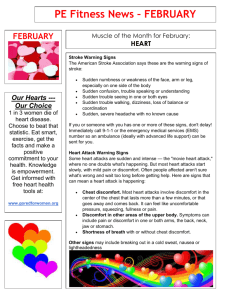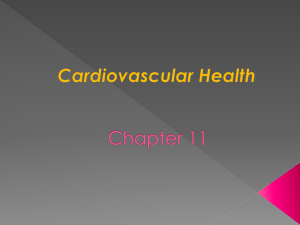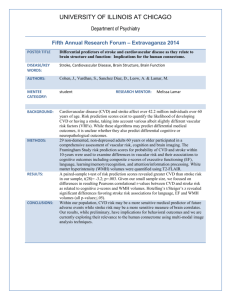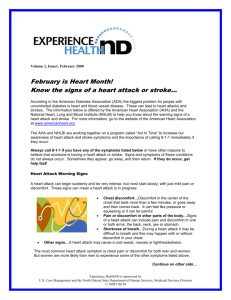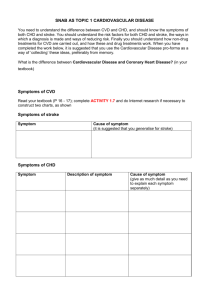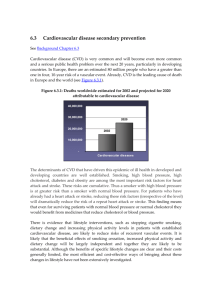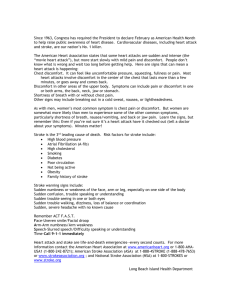lecture14_C
advertisement
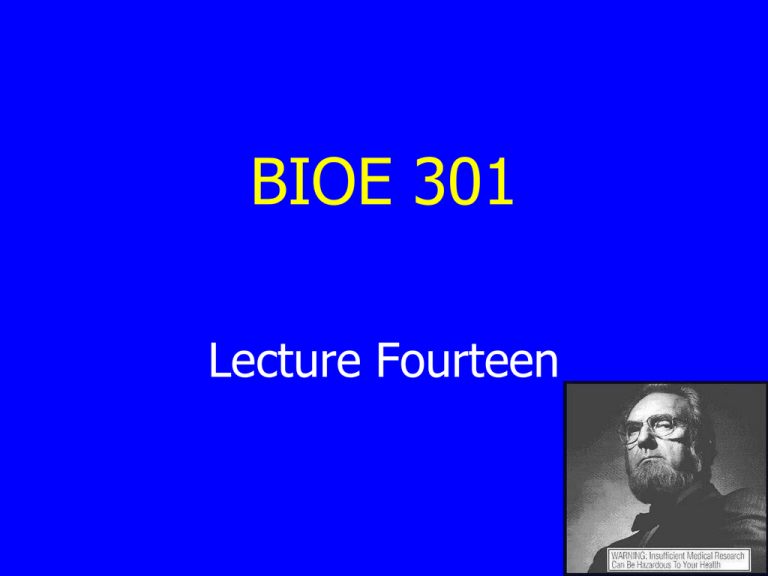
BIOE 301 Lecture Fourteen Win $1000 http://www.smartglobalhealth.org/pages/ essay-signup Four Questions What are the major health problems worldwide? Who pays to solve problems in health care? How can technology solve health care problems? How are health care technologies managed? Two Case Studies Prevention of infectious disease Early detection of cancer HIV/AIDS Cervical Cancer Ovarian Cancer Prostate Cancer Treatment of heart disease Atherosclerosis and heart attack Heart failure Outline The burden of heart disease The cardiovascular system How do heart attacks happen? How do we treat atherosclerosis? Open heart surgery Angioplasty Stents What is heart failure? How do we treat heart failure? Heart transplant Left ventricular assist devices Artificial heart Burden of Heart Disease US and Worldwide Global Burden-Cardiovascular Disease In 1999: In 2003: CVD contributed to a third of global deaths 16.7 million deaths due to CVD By 2010: CVD is estimated to be the leading cause of death in developing countries 2002 Worldwide Mortality Burden of CVD: United States CVD: About 61 million Americans (almost ¼ of population) have CVD Accounts for more than 40% of all deaths 950,000 Americans die of cardiovascular disease each year Two main forms of CVD: Ischemic Heart disease: Leading cause of death in US Coronary heart disease is a leading cause of premature, permanent disability among working adults Stroke Ischemic heart disease Stroke Third leading cause of death in the US Cost of CVD disease: $351 billion $209 billion for health care expenditures $142 billion for lost productivity from death and disability Mortality in Developing Countries US: Burden of Heart Attack Consequences of ischemic heart disease Caused by a narrowing of the coronary arteries that supply blood to the heart Often results in a heart attack Each year: 1.1 million Americans suffer a heart attack 460,000 of those heart attacks are fatal Half of those deaths occur within 1 hour of symptom onset, before person reaches hospital Early Detection of CVD Risk Factors: Tobacco use Low levels of physical activity Inappropriate diet High blood pressure – Over 70% not under control High cholesterol – Over 80% not under control Screening for CVD: Measure BP annually 12-13 point reduction in blood pressure can reduce heart attacks by 21% Check cholesterol every 5 years 10% drop in cholesterol can reduce heart attacks by 30% Of Those With High BP: Blood Pressure My blood pressure = 103/68 Normal blood pressure: Varies from minute to minute Varies with changes in posture Should be < 120/80 mm Hg for an adult Pre-hypertension: The higher (systolic) number represents the pressure while the heart is beating The lower (diastolic) number represents the pressure when the heart is resting between beats Blood pressure that stays between 120-139/80-89 Hypertension: Blood pressure above 140/90 mm Hg How Do We Measure BP? Sphygmomanometer Dr. RRK wastes two minutes of class times and proves that you can find anything on the internet Increase cuff pressure until it is higher than systolic pressure http://www.youtube.com/watch?v=ynjIoymWHvU Blood flow into arm stops Gradually release pressure When cuff pressure = systolic pressure: Blood begins to flow again Hear Korotkoff sound associated with turbulent flow through artery When cuff pressure = diastolic pressure: Artery is no longer compressed No longer hear Korotkoff sound How Do We Measure Blood Pressure? http://cwx.prenhall.com/b ookbind/pubbooks/silverth orn2/medialib/Image_Ban k/CH15/FG15_07a.jpg Serum Cholesterol Levels Total Cholesterol Optimal LDL HDL under 100 above 60 Desirable under 200 under 130 Borderline 200-239 130-159 Abnormal over 240 over 160 below 35 LDL causes cholesterol to build up inside blood vessels. HDL actually removes cholesterol from the walls of blood vessels and brings it back to the liver to be safely excreted. The Cardiovascular System Fig 14.7 a-d – The Cardiovascular System Silverthorn 2nd Ed http://www.innerbody.com/anim/heart.html http://www.pbs.org/wgbh/nova/eheart/human.html Fig 14.7 e-h – The Cardiovascular system Silverthorn 2nd Ed Fig 14.1 – General anatomy of the circulatory system Silverthorn 2nd Ed Quantifying Heart Performance Heart Rate (HR) Stroke Volume (SV) Amount of blood pumped by ventricle with each heart beat Normal value is 60-80 ml Cardiac output (CO) Number of heart beats per minute Normal value is 60-90 bpm at rest Total volume of blood pumped by ventricle per minute CO = HR x SV Normal value is 4-8 L/min Blood volume Total volume of blood in circulatory system Normal value is ~5 L Total volume of blood is pumped through our heart each minute!! Quantifying Heart Performance Ejection Fraction (EF) Fraction of blood pumped out of ventricle relative to total volume (at end diastole) EF = SV/EDV Normal value > 60% Measured using echocardiography Normal echocardiogram http://www.ardingerphoto.com/pcawebsite/cardiology /movies/sssmovies/normallao2cycle.html Dilated cardiomyopathy http://www.ardingerphoto.com/pcawebsite/cardiology /movies/sssmovies/dilcardiomyopsss.html Heart Attacks Pathophysiology Diagnosis Treatment Heart Attacks Pathophysiology Case Study • Three months following his first visit to your office, Mr. Solomon presents to the ER in the early morning, with chest pain of one hour duration. • Mr. Solomon describes the pain as being severe and "like someone was sitting on his chest." The pain, located "in the lower part of my breast bone," awakened him from his sleep. Although he tried to relieve the pain by changing positions in bed, sitting up and drinking water, it remained unchanged. • He did not sleep well because "I had an upset stomach an acidburning feeling." He attributed these symptoms to over eating and drinking at a Christmas party. • He has no pain or discomfort in his arms but says he has an "acheness" in his left jaw which he attributes to "bad teeth." • Physical examination reveals the patient to be anxious, pale, diaphoretic and in obvious discomfort. He is unshaven and accompanied by his wife. He tries to relieve his pain by belching. He coughs occasionally. Mr. Solomon says "the flu has been going around the office, and I’ve had a little cough and fever all week." • http://www.meddean.luc.edu/lumen/meded/mech/cases/case2/Case_f.htm Early Warning Signs of Heart Attack Many heart attacks start slowly; symptoms may come and go Chest discomfort Discomfort in other areas of the upper body Can include pain or discomfort in one or both arms, the back, neck, jaw, or stomach Shortness of breath Most heart attacks involve discomfort in the center of the chest that lasts for more than a few minutes, or goes away and comes back. The discomfort can feel like uncomfortable pressure, squeezing, fullness, or pain Often comes along with chest discomfort. But it also can occur before chest discomfort Other symptoms May include breaking out in a cold sweat, nausea, or lightheadedness Heart Attack Signs http://www.nhlbi.nih.gov/actintime/video. htm http://www.pathology.vcu.edu/education/ cardio/images/1d.a.jpg http://medlib.med.utah.edu/WebPath/jpeg5/CV119.jpg http://www.medimagery.com/patho logy.jpeg Heart Attack Video http://www.heart1.com/attack/guidant.cf m Heart Attacks Treatment of Acute Occlusion: tPA Tissue Plasminogen Activator Tissue plasminogen activator (tPA): A thrombolytic agent (can dissolve blood clots) Approved for use in certain patients having heart attack or stroke Clinical Studies: tPA and other clot-dissolving agents can reduce the amount of damage to the heart muscle and save lives To be effective, they must be given within a few hours after symptoms begin Administered through an intravenous (IV) line in the arm by hospital personnel Patients treated within 90 minutes after onset of chest pain are one-seventh as likely to die compared to patients who receive therapy after 90 minutes Thrombolytics Risks of thrombolytics: Intra-cranial hemorrhage Increased risk in those > age 70 Patients may require further intervention Costs of thrombolytics: tPA = $2300 Streptokinase = $320 Effectiveness of Thrombolytics Clinical Trial: In 15 countries and 1081 hospitals 41,021 patients with evolving myocardial infarction Randomly assigned to 4 different strategies: Streptokinase and subcutaneous heparin Streptokinase and IV heparin Accelerated tissue plasminogen activator (t-PA) and IV heparin Combo of streptokinase plus t-PA with IV heparin Primary end point was 30-day mortality Result: Streptokinase & subcut. heparin: 7.2% (stroke 0.49%) Streptokinase & IV heparin: 7.4% (stroke 0.54%) Accelerated t-PA & IV heparin: 6.3% (stroke 0.72%) Combo of both with IV heparin: 7.0% (stroke 0.94%) Cost-Effectiveness of Thrombolytics Therapy tPA Patient Group Post MI high risk tPA Acute MI, large infarct, treatment started >2 hours post Counseling Smoking cessation CABG Two vessel disease, severe angina $ per yr life saved $3,600 $24,200 $1300-$3900 $9,200-$42,500 http://www.sciencedirect.com/science?_ob=ArticleURL&_aset=B-WA-A-A-A-MsSAYZA-UUA AUYWDCBYZYAUYUBBVZZYBWAUBWEUBAU&_rdoc=1&_fmt=full&_udi=B6T1048NJXK25&_cover Date=5%2F22%2F2003&_cdi=4876&_orig=search&_st=13&_sort=d&view=c&_acct=C00000437 8&_version 1&_urlVersion=0&_userid=108429&md5=5f493caa5f65762c23c0d90eaea8b92d Heart Attacks Diagnosis of Atherosclerosis Detection of Atherosclerosis Assignments Due Next Time Project Proposal Presentations
